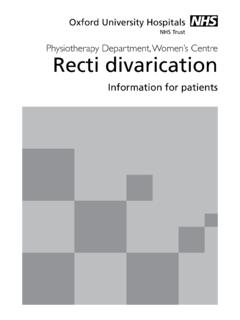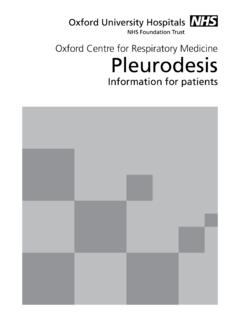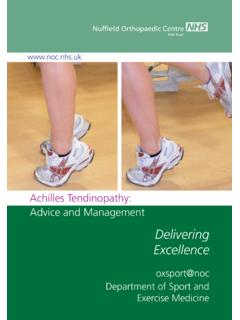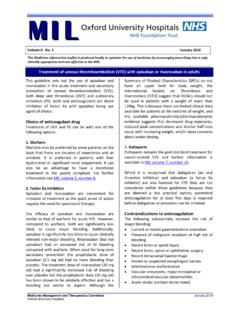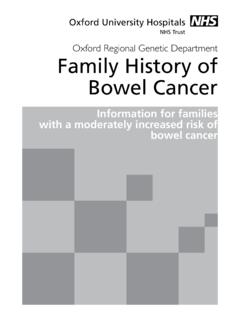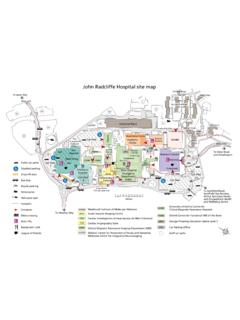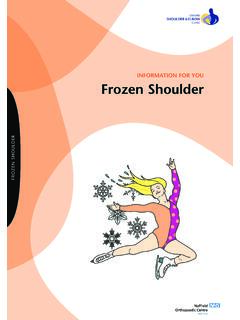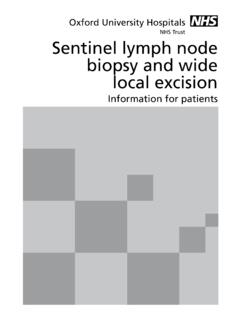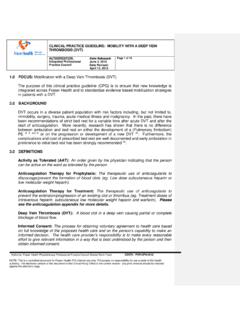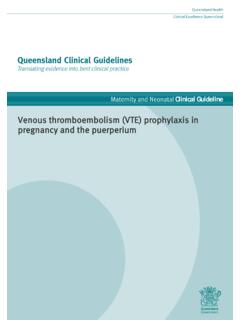Transcription of OUTPATIENT DVT SERVICE PROTOCOLS
1 OXFORD HAEMOPHILIA AND THROMBOSIS CENTRE OUT- PATIENT DVT SERVICE PROTOCOLS Version , November 2021. DO NOT PRINT This is a controlled document. It becomes uncontrolled once printed or copied. It is important that the most current version is used It is available at Anticoagulation & Thrombosis PROTOCOLS & Guidance Updated by N. Curry with input and review from S. Shapiro, C Davies, M Collins, V Price, and L. Wood. Table of Contents Referrals to the DVT SERVICE .. 4 Exclusion criteria .. 4 Mental health patients from Warneford & Littlemore Hospitals and Fulbrook & Fiennes Wards .. 4 Out of Hours Referrals .. 5 Interim anticoagulation .. 5 Transport .. 6 Diagnostic algorithm for suspected DVT .. 6 Pre-test probability assessment .. 6 Diagnostic Algorithm .. 7 Ultrasound .. 8 Patients with bilateral symptoms.
2 8 Patients with high clinical suspicion, a grossly swollen leg, but a negative scan .. 8 Thrombolytic therapy .. 9 Diagnosis of a recurrence in the ipsilateral leg.. 9 Second 9 Patients who have a DVT excluded .. 9 Patients who have a DVT diagnosed .. 9 Investigations .. 9 Investigation for cancer in patients with unprovoked DVT .. 10 Out patient treatment of DVT .. 10 Treatment with apixaban .. 10 Treatment with rivaroxaban .. 11 Treatment with low molecular weight heparin and 12 Selecting an oral anticoagulant .. 14 Continuing LMWH (in those unable to take oral anticoagulation) .. 14 Other factors to consider when deciding on anticoagulation .. 14 Body weight over 120kg or with a BMI over 40kg/m2 .. 14 Cancer- related VTE .. 15 Patients who have undergone bariatric surgery or bowel resection, or have malabsorption.
3 15 Antiplatelet medication .. 15 Duration of treatment and follow 15 Testing for thrombophilia .. 17 Compression stockings .. 18 Superficial Thrombophlebitis (STP) .. 18 Foam sclerotherapy .. 19 Incidentally discovered asymptomatic DVTs and PEs .. 19 Upper limb DVT .. 19 Women on the combined oral contraceptive pill (COCP) .. 20 DVT patients who when reviewed are suspected to have concomitant symptomatic 20 Referral to DVT SERVICE on discharge for patient with VTE treated with LMWH/warfarin .. 20 DVT .. 20 PE .. 20 Referral for three month review of VTE patients .. 21 References .. 22 Referrals to the DVT SERVICE The DVT SERVICE accepts adult patients suspected of having a lower limb DVT who are suitable for out-patient assessment and treatment. It operates seven days a week, 9-5 Mon-Fri, 9-1 Sat/Sun/Bank Holidays.
4 On Christmas Day and New Year s Day the SERVICE is closed. New patients need to arrive on time for their appointment to be guaranteed an ultrasound scan due to the availability of the sonographer staff. Referrals are by telephone to the DVT nurse. They will take details and also ask for a brief letter to either accompany the patient or be emailed to Mon to Fri telephone 01865 225629 Sat and Sun telephone switchboard (01865 741841) and bleep 5165 Exclusion criteria Pregnancy (patients 16 pregnant go to the maternity assessment unit (MAU) (20221) and patients < 16 weeks pregnant go to the ambulatory assessment unit (part of acute general medicine) (21812; consultant bleep 4658). Patients under 16 years of age Suspected upper limb DVT In-patients (unless investigation complete and being discharged) Unable to transfer from chair to chair by self.)
5 Suspected pulmonary embolism >180 kg Active bleeding Known to be at increased risk of bleeding, o Active peptic ulceration o Liver disease (INR ) o Renal insufficiency: creatinine > 200 mol/L with unknown eGFR or creatinine clearance < 20ml/min, found at: Creatinine Clearance (Cockcroft-Gault Equation) o Uncontrolled hypertension (>200/110 mmHg) o Recent (<1/12) eye or CNS surgery o Recent (<1/12) haemorrhagic stroke Patients with inherited bleeding disorders or thrombocytopenia (platelets <100 x 109/L) or with a Hb < 100 g/L should be discussed with a doctor in the Haemophilia and Thrombosis Centre or with the on-call haematology registrar. At the weekend (and on bank holidays) we cannot accept patients who require hospital transport. Mental health patients from Warneford & Littlemore Hospitals and Fulbrook & Fiennes Wards Warneford and Littlemore Hospitals Patients can attend the DVT clinic on an OUTPATIENT basis if escorted by an appropriate member of staff.
6 When discharged from the DVT SERVICE the patient s anticoagulant care will be the responsibility of these hospitals. Fulbrook (Churchill) & Fiennes (Horton) These are inpatient wards and ward staff should be advised to refer to inpatient medical team for diagnosis and management of DVTs. Mental health patients at the Fullbrook centre can attend the DVT clinic on an OUTPATIENT basis if escorted by an appropriate member of staff. Out of Hours Referrals A GP seeing a patient with suspected DVT out of hours should decide whether they are suitable for out-patient assessment and treatment (see exclusion list above). If they are not suitable the patient should be referred to the on-call medical team at the JR (01865 741166). If they are suitable for out-patient assessment and treatment a dose of either Low Molecular Weight Heparin (LMWH), apixaban or rivaroxaban should be given (dosing below) and an appointment arranged for the DVT Clinic the following day.
7 A blood sample for D-dimer testing should be taken before anticoagulation is given. This should be given to the patient to bring to their DVT appointment. D-dimers cannot be used as part of the diagnostic algorithm once patients have received a dose of anticoagulant so this sample is critical for effective diagnosis and use of resources. Interim anticoagulation Dose of dalteparin Weight (kg) Dose by subcutaneous injection using a pre-filled syringe Less than 46 7,500 once daily 46-56 10,000 once daily 57-68 12,500 once daily 69-82 15,000 once daily 83-98 18,000 once daily 99-112 10,000 twice daily 113-137 12,500 twice daily 138-165 15,000 twice daily More than 166 18,000 twice daily Dose of apixaban 10 mg bd - supply four 5 mg tablets in order to ensure a dose is not missed before review at DVT clinic (patient to take 10 mg stat and 10 mg 12 hours later).
8 Dose of rivaroxaban 15 mg bd - supply two 15 mg tablets in order to ensure a dose is not missed before review at DVT clinic (patient to take 15 mg stat and 15 mg 12 hours later). Apixaban and rivaroxaban should not be used in pregnancy or breast feeding, In patients weighing more than 98 kg therapeutic dalteparin doses are to be given twice daily and the GP should arrange for the appropriate dosing regimen. Please discuss with the clinical team, if this is practically difficult. The GP should either email or leave a message on the answerphone (01865 225629) to alert the clinic of the patient. A telephone number for the patient must be given so that the DVT clinic can phone the patient the following morning to arrange an appointment. Transport If transport is needed for the first visit this will need to be arranged by the patient s own GP the following morning (a return journey should be booked with the patient arriving at the clinic at and being collected at ).
9 Please note that the DVT clinic is unable to accept patients requiring hospital transport at weekends. Patients requiring hospital transport should either be given an appointment on the next working day and provided with anticoagulation until this appointment or referred to the Ambulatory Assessment Unit at the John Radcliffe for investigation. Patients who do not have the return journey booked will have a taxi arranged by the DVT clinic and the GP surgery will be contacted for reimbursement. Copies of our leaflet Welcome to the DVT Clinic giving information to patients on how to get to the clinic and what to expect, can be downloaded from our website. Diagnostic algorithm for suspected DVT Pre-test probability assessment Patients will initially have a pre-test probability assessment (Keeling, et al 2004, Wells, et al 1997, Wells, et al 2003, Wells, et al 1995) by a DVT nurse and be classified as unlikely or likely to have a DVT (see table below).
10 The nurse will then follow the algorithm in the figure overleaf. Points Active cancer (patient receiving treatment for cancer within the previous six months or currently receiving palliative treatment) 1 Paralysis, paresis, or recent plaster immobilisation of the lower extremities 1 Recently bedridden for 3 days or more, or major surgery within previous twelve weeks 1 Localised tenderness along the distribution of the deep venous system 1 Entire leg swollen 1 Calf swelling at least 3 cm larger than the asymptomatic leg (measured ten cm below tibial tuberosity) 1 Pitting oedema confined to the symptomatic leg 1 Collateral superficial veins (nonvaricose) 1 Previously documented venous thromboembolism 1 Alternative diagnosis at least as likely as deep vein thrombosis -2 In cases in which it is unclear as to whether there is an alternative diagnosis the assumption of no alternative diagnosis will ensure the highest level of safety.
